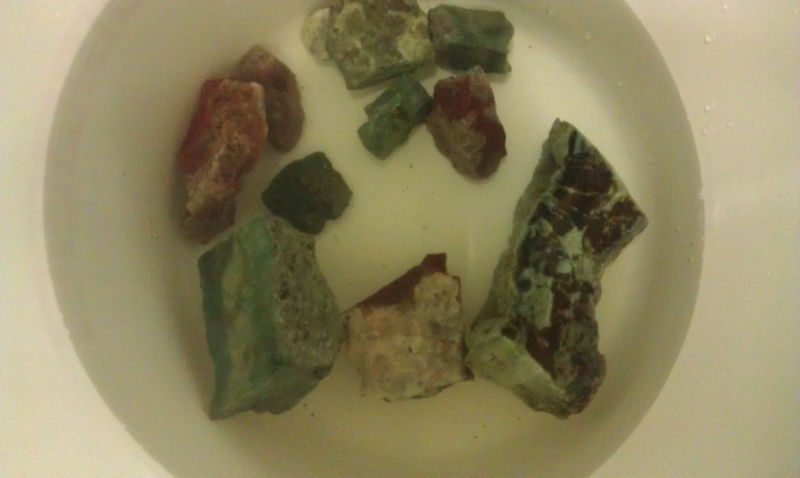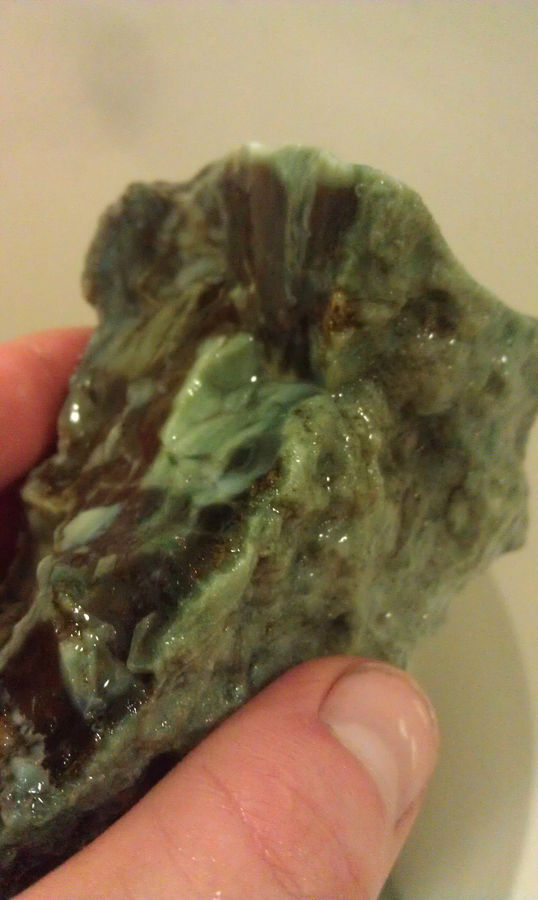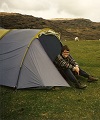| View previous topic :: View next topic |
| Author |
Message |
Rei
Joined: 09 Apr 2014
Posts: 228
Location: H÷fuborgarsvŠi



|
 Posted: Apr 26, 2014 20:22 Post subject: Cleaning with oxalic acid Posted: Apr 26, 2014 20:22 Post subject: Cleaning with oxalic acid |
|
|
So I did a test run of cleaning some chalcedony samples in oxalic acid. And... well, look at the pictures. Is that... normal? That the non-chalcedony parts turned sky blue and white? Does this mean that they're only half dissolved and will continue to dissolve away in the oxalic? Or are they going to remain like that indefinitely? If oxalic won't finish the job, would hydrochloric?
The oxalic acid is a 1.25% by mass solution (100g in 8l) - I chose that because one instruction page I saw said to dissolve 25 grams per gallon and one said 100 grams per gallon, this is 50 grams per gallon. I filled it with hot water from the tap, but of course that cooled while it was sitting outside. It's been at ambient temperature outside, which unfortunately, as this is Iceland, is always cool (I know that significantly slows the reaction time). For the photos, I took the pieces out and washed them in cold water. Our cold water here is not hard. Our hot water is volcanic, however, and so may have some dissolved minerals.
Thoughts?
| Description: |
Treating chalcedony with oxalic acid
Hvalfj÷rur, Iceland |
|
| Viewed: |
19504 Time(s) |

|
| Description: |
Treating chalcedony with oxalic acid
Hvalfj÷rur, Iceland |
|
| Viewed: |
19483 Time(s) |

|
|
|
| Back to top |
|
 |
Pierre Joubert
Joined: 09 Mar 2012
Posts: 1605
Location: Western Cape



|
 Posted: Apr 27, 2014 05:10 Post subject: Re: Cleaning with oxalic acid Posted: Apr 27, 2014 05:10 Post subject: Re: Cleaning with oxalic acid |
|
|
| Rei wrote: | So I did a test run of cleaning some chalcedony samples in oxalic acid. And... well, look at the pictures. Is that... normal? That the non-chalcedony parts turned sky blue and white? Does this mean that they're only half dissolved and will continue to dissolve away in the oxalic? Or are they going to remain like that indefinitely? If oxalic won't finish the job, would hydrochloric?
The oxalic acid is a 1.25% by mass solution (100g in 8l) - I chose that because one instruction page I saw said to dissolve 25 grams per gallon and one said 100 grams per gallon, this is 50 grams per gallon. I filled it with hot water from the tap, but of course that cooled while it was sitting outside. It's been at ambient temperature outside, which unfortunately, as this is Iceland, is always cool (I know that significantly slows the reaction time). For the photos, I took the pieces out and washed them in cold water. Our cold water here is not hard. Our hot water is volcanic, however, and so may have some dissolved minerals.
Thoughts? |
Neither jasper or chalcedony should be affected by Oxalic acid. It will only remove the dirt.
_________________
Pierre Joubert
'The tree of silence bears the fruit of peace. ' |
|
| Back to top |
|
 |
Rei
Joined: 09 Apr 2014
Posts: 228
Location: H÷fuborgarsvŠi



|
 Posted: Apr 27, 2014 05:28 Post subject: Re: Cleaning with oxalic acid Posted: Apr 27, 2014 05:28 Post subject: Re: Cleaning with oxalic acid |
|
|
I know that. But what about the turning sky blue/white of the non-chalcedony parts of the sample? Will they fully dissolve with time or are they going to persist? It's rare to find an intact piece of chalcedony that doesn't have a crust of some kind on it on two sides, as it's a crack-filling mineral.
The oxalic is having no effect on the chalcedony itself. It's what's going on with the non-chalcedony stuff that I want to remove that has me concerned.
|
|
| Back to top |
|
 |
Jordi Fabre
Overall coordinator of the Forum

Joined: 07 Aug 2006
Posts: 4894
Location: Barcelona



|
|
| Back to top |
|
 |
Rei
Joined: 09 Apr 2014
Posts: 228
Location: H÷fuborgarsvŠi



|
 Posted: Apr 27, 2014 08:08 Post subject: Re: Cleaning with oxalic acid Posted: Apr 27, 2014 08:08 Post subject: Re: Cleaning with oxalic acid |
|
|
Is that the thread you meant to post? It says nothing about sky blue/white bleaching of non-chalcedony and whether it will ultimately dissolve (as intended) or will persist.
If the answer is that it will not ultimately dissolve, is it safe to mix hydrochloric acid into the oxalic acid? I was thinking that if the two chemicals are compatible (they should be...), it might be very effective - HCl's low pH with oxalic's high affinity for chelation, it might kick things up a notch.
|
|
| Back to top |
|
 |
Jordi Fabre
Overall coordinator of the Forum

Joined: 07 Aug 2006
Posts: 4894
Location: Barcelona



|
 Posted: Apr 27, 2014 08:29 Post subject: Re: Cleaning with oxalic acid Posted: Apr 27, 2014 08:29 Post subject: Re: Cleaning with oxalic acid |
|
|
You are frequently looking for specific answers to specific questions and often you will find that there are no such answers (or not useful answers) So, it could be necessary that you try to fix them by yourself, and to do it you should understand more broadly the issues about you are asking (e. g, how oxalic acid and other cleaning agents work...)
Cheers
|
|
| Back to top |
|
 |
Rei
Joined: 09 Apr 2014
Posts: 228
Location: H÷fuborgarsvŠi



|
 Posted: Apr 27, 2014 09:39 Post subject: Re: Cleaning with oxalic acid Posted: Apr 27, 2014 09:39 Post subject: Re: Cleaning with oxalic acid |
|
|
Okay... if you don't know the answer, you don't have to reply; I just assumed that there would be people with experience cleaning minerals on this forum, and given that oxalic is one of the three most commonly cited ways to clean quartz-bearing minerals, I figured at least one person would know if forming a sky-blue to white crust on non-quartz-based surfaces is normal behavior and whether it typically disappears.
What lack of understanding about how oxalic works have I presented? Oxalic acid works by leaching and chelating metal ions, particularly iron, in a low-pH environment (iron becomes bound up as ferrioxalate, which tints the acid green). Its reaction rate is heat-depedendent. When most of the oxalate is bound up with iron, the reaction rate slows and the solution needs to be changed. Thorough soaking afterwards in non-hard-water is essential to prevent the surface deposition of oxalates.
What have I left out?
Ed: Sorry if I came across as curt here - it just sounded like you were encouraging me to not ask questions about people's experience cleaning minerals, which I found really strange for a minerals forum, esp. after you passed me off to a link that didn't talk about my issue.
|
|
| Back to top |
|
 |
Mike Wood

Joined: 16 Dec 2010
Posts: 456
Location: Northern England



|
 Posted: Apr 27, 2014 18:05 Post subject: Re: Cleaning with oxalic acid Posted: Apr 27, 2014 18:05 Post subject: Re: Cleaning with oxalic acid |
|
|
Hello Rei,
oxalic acid is used (so I have read) to dissolve unwanted thin iron stains from mineral specimens. It seems like you are trying to dissolve rock (basalt) from your mineral specimen (chalcedony). This would be a tough job for oxalic acid; only very strong acids would do that - but it is a perilous road to go down.
A better way would be to scrape or chisel gently away at the basalt to remove as much as you can - remove the unwanted material mechanically not chemically.
Alternatively, all you could do is to try and find some larger or naturally 'cleaner' samples of chalcedony in the boulders.
I would not recommend mixing acids (or any chemicals, for that matter) if you don't know what the reaction would be. I have an interest in chemistry, but I don't know what would happen if oxalic acid and hydrochloric acid were mixed together. As oxalic acid can be unstable (at high temperature, evolving carbon monoxide) I can imagine bad things happening (evolution of chlorine, chlorine dioxide, carbon monoxide...?) But I don't know for sure and I wouldn't try it myself.
Careful now!
Mike : ]
_________________
Rock basher |
|
| Back to top |
|
 |
Rei
Joined: 09 Apr 2014
Posts: 228
Location: H÷fuborgarsvŠi



|
|
| Back to top |
|
 |
Mike Wood

Joined: 16 Dec 2010
Posts: 456
Location: Northern England



|
 Posted: Apr 28, 2014 14:59 Post subject: Re: Cleaning with oxalic acid Posted: Apr 28, 2014 14:59 Post subject: Re: Cleaning with oxalic acid |
|
|
"It's very common for chalcedony to have a thin crust, maybe a couple millimeters thick, of its surface rock on two sides. Is oxalic only good for dissolving thin sub-millimeter films? "
Yes I think so - thin stains of Fe-hydroxides ( such as 'limonite' ).
If you want to persist with your aggressive chemical experiments, then good luck; I would not recommend it, nor do I think any mineral forum would recommend these actions. If you happened to be an experienced chemist, with a proper laboratory, fume cupboard, blast screen and safety gear, first aid kit (eyewash!), rubber gauntlets etc.etc. then yeah maybe you can dissolve rock.
If I were you I would go back out to the land, and try and find some better (cleaner) chalcedony pieces. I would use a 1-2kg club hammer and a good quality steel alloy chisel. And protective gloves (a thick cushioned glove on the chisel hand) and goggles.
Seriously!
Mike
_________________
Rock basher |
|
| Back to top |
|
 |
Rei
Joined: 09 Apr 2014
Posts: 228
Location: H÷fuborgarsvŠi



|
 Posted: Apr 28, 2014 18:50 Post subject: Re: Cleaning with oxalic acid Posted: Apr 28, 2014 18:50 Post subject: Re: Cleaning with oxalic acid |
|
|
Try to find chalcedony that doesn't have a crust? But it grows with a crust, inward from the edges of a crack; it's like saying "find a geode that doesn't have a crust". Only pieces broken on all sides wouldn't have one. Must I only collect highly broken fragments?
I'm trying a pure (30%) HCL cleaning now on some other pieces. Following the guidelines I've seen everywhere for HCL cleanings. Standard precautions taken - full-body suit, rubber gloves, rubber boots, eye protection. The rocks were bubbling quite vigorously in the beginning, I doubt I need anywhere near 30%. It had slowed down the last time I checked, so hopefully they'll be nice and clean tomorrow. :)
|
|
| Back to top |
|
 |
Mike Wood

Joined: 16 Dec 2010
Posts: 456
Location: Northern England



|
 Posted: Apr 29, 2014 12:34 Post subject: Re: Cleaning with oxalic acid Posted: Apr 29, 2014 12:34 Post subject: Re: Cleaning with oxalic acid |
|
|
"Try to find chalcedony that doesn't have a crust? But it grows with a crust, inward from the edges of a crack; it's like saying "find a geode that doesn't have a crust". Only pieces broken on all sides wouldn't have one. Must I only collect highly broken fragments?"
Hello Rei, I was assuming that maybe you were going to polish the chalcedony/jasper/chrysoprase, so any undesirable waste rock could be sawn off or chipped off, before grinding and polishing. Sorry for any misunderstanding! It may be possible to find loose, larger pieces of chalcedony... Also, the pieces you find which are naturally loose and free from the rock will for sure be more solid pieces, as any weakness in the chalcedony will already have been 'found' by natural processes.
When I collect geodes, in my case I want to keep the 'skin' or rock lining of the geode, because that is supporting the crystals within, which I want to keep intact!
(From Vic's thread)
"No need for head protection yet, I'm only getting started on my land so there's no "tunnels" (yet). The biggest risk as it stands looks to be undermining boulders on the slope above me, though, so I try to watch out for that.... the last thing I want is to get crushed :Ů What do you do to avoid that? Or is that not a problem there?"
Rei, the safest thing to do with boulders on a slope is to push them down (whilst standing above); maybe sit down and push with your feet, or get a big crowbar and lever them down (assuming, of course, that there is nothing at the bottom of the slope that you can damage!). If they are too big to move, then they are probably safe; just be very aware of any movement whilst you are working. When the boulder splits, don't be in the way of the part that splits off! (Sounds obvious, but they can split unexpectedly. I once was splitting a boulder and about a half-tonne of basalt suddenly broke off and rested on my boots (steel toecapped, fortunately), which I wasn't expecting and could have been nasty.)
A hardware store, or builder's merchant would have some cold chisels. The best ones are alloy steel (Cr+V+Mo) and are usually 'flat' in cross-section. The alloy steel 'points' (octagonal) are very good also (for 'busting' rock, as opposed to splitting). Normal (cheaper) cold chisels which are more commonly available are usually carbon-steel and hexagonal in cross-section (across the shaft) but are less durable.
"I'm trying a pure (30%) HCL cleaning now on some other pieces. Following the guidelines I've seen everywhere for HCL cleanings. Standard precautions taken - full-body suit, rubber gloves, rubber boots, eye protection. The rocks were bubbling quite vigorously in the beginning, I doubt I need anywhere near 30%. It had slowed down the last time I checked, so hopefully they'll be nice and clean tomorrow. :)"
I admire your persistance (!) and good luck with your efforts. I'm sure Loki would be proud of you..
Mike ;-)
_________________
Rock basher |
|
| Back to top |
|
 |
Rei
Joined: 09 Apr 2014
Posts: 228
Location: H÷fuborgarsvŠi



|
 Posted: Apr 29, 2014 14:00 Post subject: Re: Cleaning with oxalic acid Posted: Apr 29, 2014 14:00 Post subject: Re: Cleaning with oxalic acid |
|
|
Thanks for all the tips (esp. about steel-toed boots... I should have thought of that!).
There's no visible bubbling from the HCL but I still want to give it another day before I check out the results. The oxalic seems to be progressing nicely, that concerning blue seems to be disappearing well and it seems to be leaving behind only the "nicer looking" stuff. :) I got myself some buffing attachments for my grinder the other day to give the faces a nice shine afterwards, and if anything looks like it needs to be cut to show the patterns better, a thin diamond blade too (small enough that I can still use the safety guard). I was thinking about trying a setup that someone mentioned on another forum for people who don't have a lapidary saw - setting up a steady drip over the workpiece to keep dust under control.
| Quote: | | I'm sure Loki would be proud of you.. |
Hehe, nah, I think what he'd like most is what my fiance and I plan to do when time allows - someone has now twice stolen gasoline from his truck, so we're working out the details on setting up a second, hidden gas fill inlet in the bed that goes to the truck's regular gas tank. The normal gas tank inlet will be severed and inserted into a small gas can filled with a mixture of gasoline and sodium silicate ;) That's the "engine killer" compound that can flow through filters but turns into sand when heated.
|
|
| Back to top |
|
 |
|


